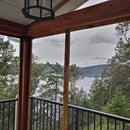Introduction: A Sanding Screen for a Boat (custom Temporary Tarpaulin/awning)
I occasionally need to work on my boat hull - repainting, fibreglass repairs. This requires removing layers of old paint with a sander or grinder, and the boatyard requires me to use a screen so the dust does not blow onto other boats. In the off-season, it's also more comfortable to work out of the wind and rain.
This project describes a transparent plastic screen that has survived many weeks of winter weather, including some moderate windstorms.
This may seem a trivial project, but without careful construction the grommets pull out and the screen blows away in the wind.
Step 1:
- Rolls of heavy-duty plastic sheet, sufficient to go twice around the boat with some overlap and about 7ft wide
- 3mm polyester cord, sufficient to go once around the boat in one length
- 3mm polyester cord, to be cut into 2ft lengths, to go once around the boat
- Duct tape. I used exterior grade transparent tape. Electrical tape can be used also, but the wider the better.
- Tarpaulin grommets (metal eyelets)
- Eyelet fitting kit (anvil, die, hollow punch)
- 1x3 wood strip, sufficient for a rectangle to go once around the boat
- Rope, enough to go the width of the boat 3x. Need not be cut, can be repurposed
- 2" screws e.g. drywall
Tools:
- Vise grips (Mole wrench)
- Screwdriver
- Hammer
- Electric drill
- Scissors/knife (to cut cord, tape, plastic sheet)
- Saw (to cut wood strips)
I have 2 kits, one with a hinged anvil but no punch, and one with a separate anvil and die, and a hollow punch.
Normally, you insert the material between the anvil and die, fit the eyelet halves, then strike the die with a hammer. This only works on a firm surface, like concrete or a solid workbench. I cut down the die so that it would fit in the jaws of the mole wrench; that way I could use it up a ladder to repair broken eyelets. Position all the materials between the anvil and die, adjust the wrench jaws for maximum mechanical advantage, and squeeze. It may be necessary to readjust the wrench for a second go.
The kit with no punch I presume was intended to be used without - maybe on thin material the eyelet itself is strong enough to punch through. This does not work on 4 layers of plastic sheet.
The punch is intended to be used by striking it against a piece of wood with a hammer. This does not work that well, and again only works on a firm surface. Using the punch as a hollow drill, so that it is rotated against the material, works very well and can be done up a ladder. Failing that, a hole can be punched through with e.g .a screwdriver then opened out using the fingers - that won't make nearly as neat or strong a hole, but is better than relying on the eyelet itself to punch a hole.
Step 2:
Constructing the screen
Unroll the plastic sheet on level ground. Unroll a second roll on top so that there are two layers with the edges lined up.
Run polyester cord the full length of the sheet along the edge.
Fold over about 3" of both sheets over the cord. Secure with tape as necessary, to stop it moving or unfolding.
Every 2 or 3 feet, add a grommet. Cut an 8" length of duct tape and fit it across the fold so that it secures the folded plastic and extends down both sides. Now drill a hole about 1.5" from the edge through all 6 layers of material and fit the grommet. The cord should be trapped between the grommet and the folded edges. The duct tape spreads the load across the sheet and minimizes tearing. The cord spreads the load beyond a single point at the edge.
Step 3:
Secure the top edge of the assembled screen to the boat using 2ft lengths of cord, or whatever works for you. It is important that the cord be secured tightly around the eyelet and also the cord in the folded-over edge.
Step 4:
Securing the base of the sheets
With the top edge secured, the screen will work fine in good weather. However, in any kind of wind the sheet will blow away from the boat and let the rain in, dust out etc. Mostly a problem if you are actually trying to work under it, or have stored materials underneath.
Lay out the wooden strips in a rectangle around the base of the screen. Lay a second later of strips across the top, trapping both layers of plastic evenly between the strips, and screw the strips together every foot or so. Stapling the sheet to just one strip won't work as the material will tear in the wind.
In high wind there is a tendency for the entire structure of wooden strips and sheets to blow away from the boat downwind. This can be addressed by securing the strips on each side together with rope running across the width of the boat. Or, I guess, by nailing the strips into the ground or weighting them down with cement blocks.













